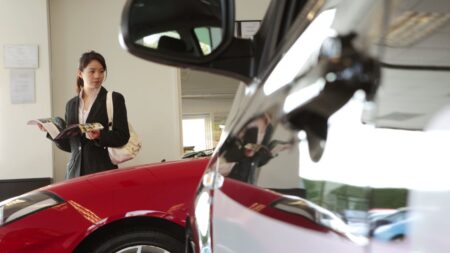Nitat Termmee/Getty Images
Key takeaways
- Investing in repairs for an old vehicle may not always be the best move for your finances.
- Repairing an old vehicle can help you avoid high new and used car prices — and high interest rates.
- If you’re facing expensive repairs on an older vehicle, buying a new vehicle may save you money over the long run.
- Compare the cost of repairs against the cost of an auto loan to determine what makes the most sense for your bottom line.
Your car requires regular investments to keep it running. At some point, however, you will question whether it’s wise to keep putting money into an old set of wheels. Should you pay for a major fix, or would it make more sense to put that cash toward a new vehicle?
Compare the cost of repairs against the potential cost of a car loan and the value of your current vehicle. These numbers can help you determine if making more repairs is a losing investment — even with sky-high car prices in the current market.
When to buy a new car vs. repair it
Fixing a car or buying a new one both come with big financial implications. As you crunch the numbers of a repair bill or calculate the cost of an auto loan, consider the benefits of each move.
Benefits of repairing your car
- You can avoid paying record-high prices: Matt Degen, senior editor at Kelley Blue Book, suggests that it may be wise to hold off on buying a new car if the repair is only a couple hundred dollars. “With the prices of new cars right now, you’re looking at a monthly payment of $600 or $700.” And while buying used can save you some money in a high-cost environment, a used set of wheels could also need repairs.
- You’ll have one bill instead of a new set of monthly responsibilities: If you can cover the repair and avoid getting locked into a new auto loan, you can keep your monthly budget in good shape. “Even if you had a high repair bill of a few thousand dollars, that would only be enough for a down payment on a new car,” says Ronald Montoya, senior editor at Edmunds. “Then, you’d still have to contend with the monthly payments for another five to six years or so.”
- You can keep your insurance costs in check: Since a used car tends to be cheaper to replace, insurance for an old car will likely be more affordable than covering a brand-new ride.
Benefits of replacing your car
- You can stop worrying about every noise your old car makes: The obvious benefit of a new car is the ability to sleep at night without worrying about dealing with another repair next week. New cars come with warranties that usually cover issues for the first three years or 36,000 miles, and some parts of the vehicle may have extended coverage up to 100,000 miles.
- You might be able to save in other areas: There are some issues that can’t be repaired — such as your car’s gas mileage — something to keep in mind in a time when the price of a gallon of gas is over $3 in some markets, according to data from AAA. “If you’re driving something that is draining your wallet,” Degen says, “it might be time to consider a hybrid or electric model.”
Buying new will cost more right now
Like many other rising costs, cars are impacted by inflation, and the price tag of new cars has skyrocketed. According to Kelley Blue Book, the average price of a new car in August 2024 was $47,870 — down nearly $1,000 from July. Thankfully, new car prices dropped below MSRP for the first time in nearly two years in March and have continued on this downward trend.
Buying used also comes with a high price tag, averaging over $25,172 in August 2024, according to Kelley Blue Book. The good news is the price increases are showing signs of slowing down and may even decline in the coming months. If you can hold off on buying a car, you may be able to get a better deal as the market levels out, especially now that the Fed rate has been cut.
How to tell if it’s time to replace your car
In some cases, there isn’t much debate over replacing versus repairing. Even if you have to take a loan for the new vehicle, it still may make sense financially over the long run if you’re able to secure a competitive auto loan rate compared to driving an unreliable vehicle that constantly requires repairs.
If any of these signals apply to your situation, it’s probably time to look for a new vehicle.
The numbers don’t add up
“If you have a car worth $5,000 and you’re looking at a repair for $4,000, it’s probably time to start looking for a new car,” Degen says.
For a car that you still owe a balance on, you may want to look into selling it before you end up upside down on the loan. In this case, it can be a better financial move to purchase another vehicle, especially if you can obtain an auto loan with favorable rates. That said, average auto loan rates have remained high — so it’s still worth determining if the cost of interest outweighs the cost of repairs.
Bankrate tip
Calculate your car’s value, then compare it with the sum of what you owe on the loan and estimated repair costs. If the second number is larger, or nearly the same, as the first, it might be time to say goodbye.
The issues are causing major headaches in your daily life
Montoya points out that if the car’s issues are creating hiccups in your daily routine — making your kids late to school or you late to work — you probably need to consider a replacement. This is especially true when said hiccups end up causing financial strain. It may be worth an added monthly cost to avoid being stuck on the side of the road when your car fails.
You have a serious safety concern
If the car can’t pass a state smog inspection test, you’re going to need to address a major issue. And if the car presents any kind of danger, start browsing.
“You can’t put a price tag on safety,” Degen says. “If your car presents a threat to you or other drivers, it’s time for a new one.”
3 tips to make your car last longer
Are you trying to squeeze some extra life out of your current car? Rather than rush to the dealer, there are a few simple car care steps to keep your car moving.
- Follow the regular service schedule: Visit the mechanic regularly to identify potential issues before they become huge problems. Get regular oil changes, replace the air filters and follow your owner’s manual to determine what you need to do. A quick trip to the mechanic at regular mileage markers can potentially extend the life of your car.
- Pay attention to alerts: Sure, that check engine light might seem like an annoyance, but it’s trying to tell you something. When your car’s system issues a warning, don’t delay — go get it checked out by an expert.
- Give it a new shine: Cosmetic clean-up can do a lot. Degen points out that paying for a good detail of your old car can make a significant difference. “It really does something for you psychologically,” he says. “Just getting into a car that looks clean and smells clean can make you think twice about the immediate need for a new one.”
The bottom line
Cars don’t last forever. If you’re considering when to buy a new car versus repair an old one, start by comparing the costs of each option. If you’ve invested a great deal of money and exhausted every repair to keep your vehicle running, it may be time to start shopping. But before you do, there is some good news: You might be able to get a good chunk of cash to help cover part of your replacement.
“Even older used cars with higher mileage are still getting record trade-in value,” Degen says. “So, that old jalopy that you have might be worth a lot more than you think it is.”
Look at your car’s current value and compare it with an estimate for the repair bill. Seeing those two numbers next to each other should give you a good idea of whether it makes more financial sense to repair or replace it.
Read the full article here
















